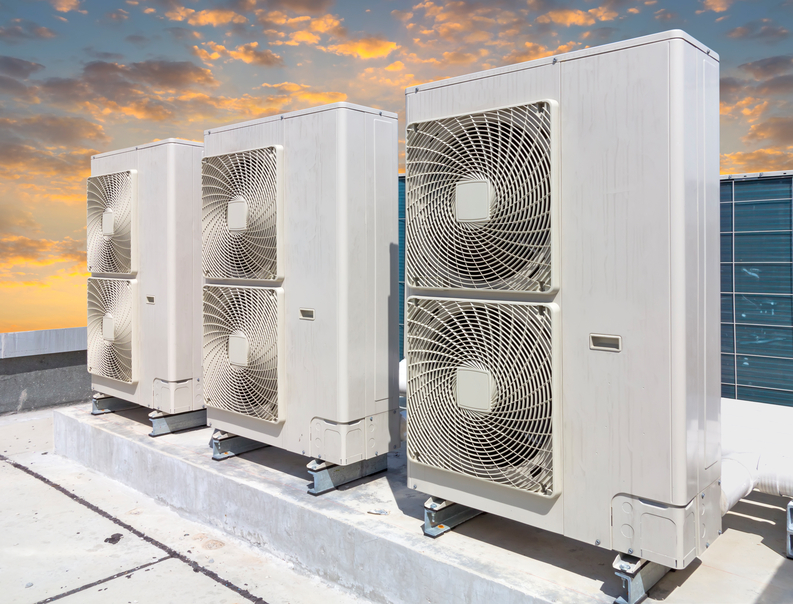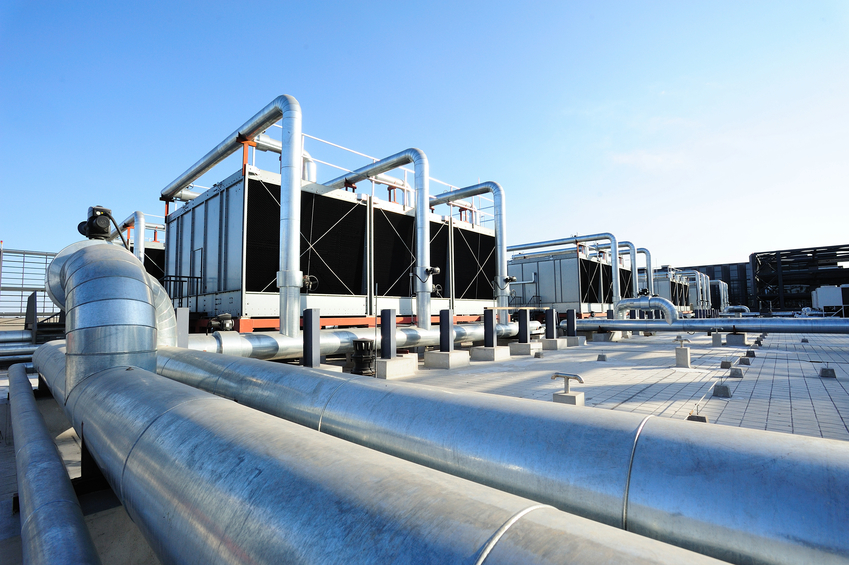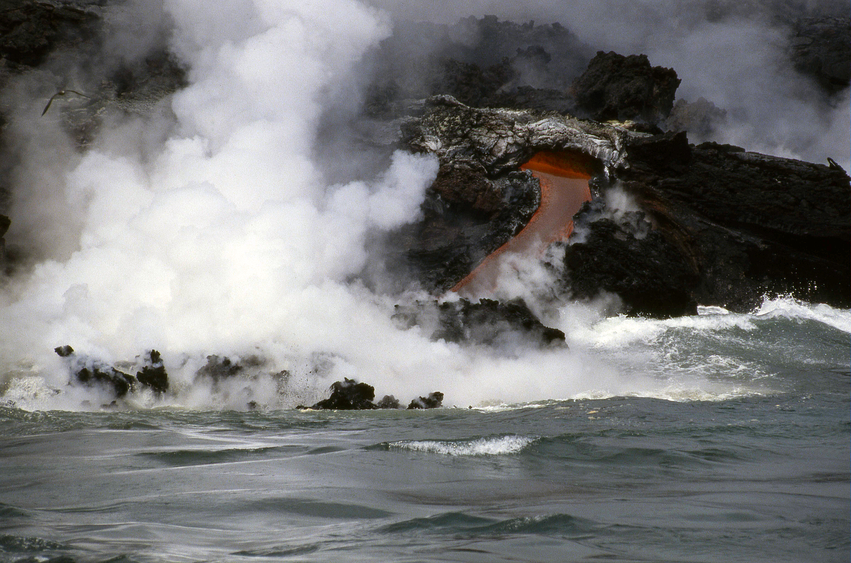HVAC Hydronic Systems 24 PDH Discount Package
Heat Pumps for Heating and Cooling (M06-047)
HVAC Chilled Water Distribution Schemes (M05-008)
HVAC Pump Characteristics and Energy Efficiency (M05-007)
Hydronic Systems (M04-008)

This online engineering PDH course discusses the applications of chiller systems.
A chiller can be generally classified as a refrigeration system that uses either a vapor compression or absorption cycle to cool. Both the absorption and the mechanical compression systems have the evaporation and condensation of a refrigerant in common. In both systems, the refrigerant evaporates at low pressure to absorb heat and then condenses at higher pressure to reject heat to the atmosphere. Both systems require energy to raise the temperature of the refrigerant for the heat rejection process.
The difference is that the mechanical chillers use reciprocating, centrifugal or screw compressors that are powered by electric motors whereas in the absorption cycle uses heat (usually steam or direct fire) to raise the refrigerant temperature. Mechanical chillers are most commonly used in residential and commercial buildings whereas absorption systems offer an excellent choice for industrial applications there waste heat recovery is an essential element of the process.
This 4 PDH online course is applicable to mechanical engineers, design and construction personnel, technical staff and facility personnel who are interested in gaining a better understanding of chiller systems.
This PE continuing education course is intended to provide you with the following specific knowledge and skills:
- How the mechanical compression cycle operates
- What are the different types of mechanical compressors
- What is vapor absorption refrigeration cycle, its components and applications
- What do the terms efficiency and coefficient of performance mean
- What are the functions of the different components of a chiller system
- How is heat rejection achieved through contact and non-contact type cooling towers
- What are the different types of refrigerants and their effects on environment
- What are the principle guidelines in sizing, costing and selecting an appropriate chiller
- Why is water treatment important in closed and open systems
- What are the basic methods and procedures for testing, adjusting and balancing (TAB) of chiller systems
In this professional engineering CEU course, you need to review Appendix C, "Chiller Systems" of the US Corps of Engineers Construction Engineering Research Laboratory (USACERL) technical report 99/20, May 1999.
Upon successful completion of the quiz, print your Certificate of Completion instantly. (Note: if you are paying by check or money order, you will be able to print it after we receive your payment.) For your convenience, we will also email it to you. Please note that you can log in to your account at any time to access and print your Certificate of Completion.

This online engineering PDH course provides fundamental knowledge of heat pumps so that you can make more informed decisions in choosing the correct system. The course covers the fundamentals, components, applications, installation of air source and geothermal heat pumps. Prior knowledge and a basic background in refrigeration and air conditioning will be helpful.
A heat pump is an electric device, which extracts heat from the air, ground or water and transfers it into the building. It is one of the most effective ways of heating water and indoor air while at the same time providing cooling (e.g. air conditioning), making them ideal for use in places where both air conditioning and heating are required.
A heat pump uses the principles of vapor compression refrigeration cycle to transfer heat from one place to another exactly in the same way as an air conditioner does. The beauty of these pumps is that they use the same refrigeration cycle for heating and cooling. Using a reversing valve, they change the coil serving as the condenser and the one serving as the evaporator. In cooler climates, people often purchase these pumps for use only as heaters. These units draw the heat from the ground or air and are often used commercially to heat offices and large apartment communities.
Their reputation started to grow since 2008, when heat pump sales in the United States and the Scandinavian countries have risen 40%. In some European countries heat pumps have already taken a significant proportion of the market for heating appliances and this is likely to be a long-term trend.
This 6 PDH online course is intended primarily for mechanical interested in gaining an understanding of heat pump application for heating and cooling.
This PE continuing education course is intended to provide you with the following specific knowledge and skills:
- Understanding the difference between a heat pump and an air conditioning unit
- Understanding the basic principles of refrigeration and the heat pump cycle
- Learning about the operation of the heat pump reversing valve
- Identifying the reversed cycle in the heating mode and cooling mode
- Learning about the various types and classifications of heat pump systems
- Learning about air source heat pump in space heating and water heating applications
- Understanding the principles of geothermal heat pumps including ground source and water source applications
- Learning about the thermal balance point and knowing when to apply auxiliary heat and defrost
- Learning about the principal parts, components, controls and accessories of heat pumps
In this professional engineering CEU course, you need to review the course document titled, “Heat Pumps for Heating and Cooling”.
Once you complete your course review, you need to take a multiple-choice quiz consisting of thirty (30) questions to earn 6 PDH credits. The quiz will be based on this course document.
Upon successful completion of the quiz, print your Certificate of Completion instantly. (Note: if you are paying by check or money order, you will be able to print it after we receive your payment.) For your convenience, we will also email it to you. Please note that you can log in to your account at any time to access and print your Certificate of Completion.

This online engineering PDH course discusses the history of chilled water distribution systems and the development of "variable primary flow system". Problems such as low delta-T syndrome associated with the chilled water pumping schemes are defined and also discussed. Finally, this course compares the advantages and disadvantages of primary-secondary and direct-primary pumping schemes.
In large commercial and industrial systems, chilled water system serves as means to transfer heat from building spaces to the refrigeration system. Initially, when energy costs were low, constant volume and primary-secondary systems provided a stable and simple operation of the chillers and distribution systems. However, as energy costs increased, particularly in the late 1970s, the efficiency of the chillers and the costs associated with operating the distribution system became more important. As a result, the need for new schemes to improve chiller performance and reduce energy costs drove the HVAC industry to advance chilled water technology, particularly in the manner that chilled water is delivered.
This 5 PDH online course is applicable to mechanical and HVAC engineers, process engineers, architects, building designers, contractors, energy auditors, facility managers who are interested in gaining a better understanding of HVAC chilled water distribution schemes.
This PE continuing education course is intended to provide you with the following specific knowledge and skills:
- The basic hydronic principles i.e. relationship of chilled water flow rate v/s cooling load and the energy savings due to adjustable speed pumps
- How do constant volume chilled water systems different from primary/secondary arrangement
- What is low delta-T syndrome and how it affects the chiller loading
- What are the causes and mitigation measures to prevent low delta-T syndrome
- Why distributed pumping arrangement is better than headered arrangement for constant flow systems
- How do primary/secondary chilled water systems create hydraulically independent loops.
- How to size the de-coupler bridge
- The characteristics of control valves and why 2-way valve is better than 3-way valve in variable flow systems
- How do the variable primary flow system compare with primary/secondary system in terms of cost and energy
- The importance of design tube velocity and rate of chilled water flow variations in variable primary flow systems
In this professional engineering CEU course, you need to review the course document titled "HVAC Chilled Water Distribution Schemes".
Upon successful completion of the quiz, print your Certificate of Completion instantly. (Note: if you are paying by check or money order, you will be able to print it after we receive your payment.) For your convenience, we will also email it to you. Please note that you can log in to your account at any time to access and print your Certificate of Completion.

This online engineering PDH course provides the students with a firm understanding of the basic principles that centrifugal pumps operate under. Topics covered include the performance curve, series operation, parallel operation, the affinity laws, friction, specific gravity & viscosity, suction lift, and NPSH.
Most HVAC systems are designed to handle the maximum potential temperature extremes, keeping the building cool on the hottest days and warm on the coldest days. As a result, the HVAC system only needs to work at full capacity on the ten or so hottest and coldest days of the year. On the other 345 days, the system could be operated at reduced capacity.
HVAC pumps are generally designed for peak conditions and the output of these systems is controlled by mechanically constricting the flow with throttling valves. This wastes energy. By using a variable speed drives, chilled water flows can be matched to actual heating and cooling demands.
This 5 PDH online course is applicable to mechanical and HVAC engineers, process engineers, architects, building designers, contractors, energy auditors, facility managers who are interested in gaining a better understanding of HVAC pump characteristics and energy efficiency.
This PE continuing education course is intended to provide you with the following specific knowledge and skills:
- Understand the basic types of pumps used in HVAC applications
- Understand the key fluid properties such as viscosity, density, temperature, specific weight, concentration and vapor pressure
- Understand why pump performance in typically rated feet of head and not pressure.
- Understand the various head terms such as suction lift, static head, discharge head, friction head, velocity head and pressure head
- Understand the laws of affinity and illustrate them with a pump operating under VFD control
- Understand the pump curve, system curve, operating point and the best efficiency point for the pump operation
- Understand the flat, smooth and drooping characteristic curve for the centrifugal pump and the applications for which it is best suited
- Understand the importance of specific speed and their relationship to the shape of impeller (radial, mixed or axial)
- Understand pump cavitation and its relationship to net positive suction head (NPSH) available and required
- Understand the various techniques for flow control including throttling, speed adjustment and multi-pump installation considerations in parallel or series arrangement
- Learn by example the method to compute the frictional head through the HVAC chilled water system
- Define the pumping system efficiency and the tips to achieve the same
In this professional engineering CEU course, you need to review the course document titled "HVAC Pump Characteristics and Energy Efficiency".
Upon successful completion of the quiz, print your Certificate of Completion instantly. (Note: if you are paying by check or money order, you will be able to print it after we receive your payment.) For your convenience, we will also email it to you. Please note that you can log in to your account at any time to access and print your Certificate of Completion.

This online engineering PDH course provides basics of the hydronic system operation and will familiarize the reader with piping system layout and operation, as well as provide an awareness of common circuiting arrangements. Topics to be discussed include auxiliary hydronic system components such as pumps, expansion tank, terminal units, distribution piping and fittings.
The circulation of hot water or chilled water to provide heat or cool the spaces is known as "Hydronic" system. It is a closed system where cold or hot water/steam runs through a heat exchanger and air is then blown over the heat exchanger to get the desired room conditions. Traditionally, HVAC systems are designed as All-Air Systems, which means that air is cooled at one location and is than distributed to the required space through ducts. All-Air Systems achieve the task of cooling a building by convection only. Hydronic system provides an alternative to cool/heat through a combination of radiation and convection inside the building.
Hydronic heating has three advantages over other types of heating systems. These advantages are comfort, efficiency, and versatile installation. With hydronics, you can move 40,000 Btu's through a 3/4" copper pipe through walls and between floors - or anywhere you need the heat - quietly and efficiently. A forced air system requires a lot of duct space, about an 8" by 14" duct, to move that much air with that many Btu's into a room.
This 4 PDH online course is applicable to mechanical engineers, design and construction personnel, technical staff and facility personnel who are interested in gaining a better understanding of hydronic systems.
This PE continuing education course is intended to provide you with the following specific knowledge and skills:
- Understand the basic hydronic systems in heating and cooling applications
- Understand the difference between once through, recirculation, open and closed systems
- Describe the components of hydronic systems such as air separators, air vents, circulators, relief valves, expansion tanks, flow control devices, miscellaneous valve and fittings
- Understand water system piping classification for main and branch feeders
- Learn about the various piping circuits including one pipe, two pipe, three pipe and four pipe systems for various applications
- Understand different type of heating and cooling terminal units such as unitary equipment, air handling units, baseboard heaters, convectors and radiators
- Learn different type of hydronic pumps including circulators, closed coupled centrifugal pumps and horizontal split casing pumps
- Understand pump cavitation and pump installation considerations; parallel or series arrangement
- Learn basic hydronic system testing, adjusting and balancing (TAB) procedures
In this professional engineering CEU course, you need to review Appendix E, "Hydronic Systems" of the US Corps of Engineers Construction Engineering Research Laboratory (USACERL) technical report 99/20, May 1999.
Upon successful completion of the quiz, print your Certificate of Completion instantly. (Note: if you are paying by check or money order, you will be able to print it after we receive your payment.) For your convenience, we will also email it to you. Please note that you can log in to your account at any time to access and print your Certificate of Completion.